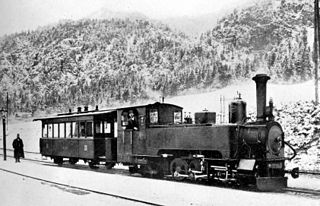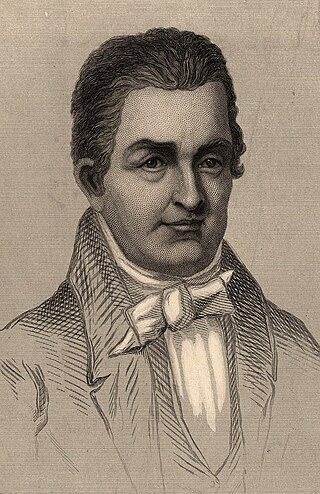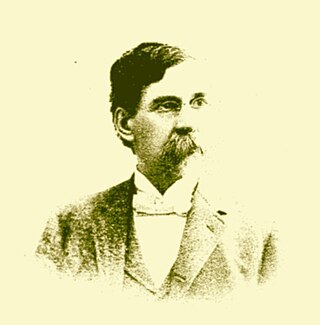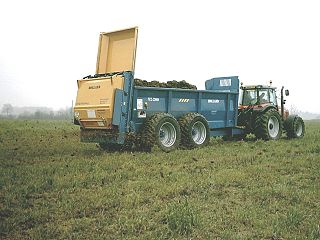
Henry Synck, Jr. was an American industrialist who participated in the development of mechanized farming.

Henry Synck, Jr. was an American industrialist who participated in the development of mechanized farming.
Henry Synck, Jr. was born in Saint Sebastian, Ohio on July 30, 1878. He married Wilhelmina Oppenheim, the daughter of Joseph Oppenheim, a teacher in Maria Stein, Ohio.
In the farming communities of Ohio, fertilization of fields was possible only by the distribution of animal excrement, usually mixed with bedding straw to create a semi-solid mixture of manure. The task of shoveling and distributing the manure was backbreaking and there were many attempts made to mechanize this process. One such example was a patent by a Daniel Merrell in 1886 for a mechanized "manure spreader". [1] There were a number of other patent filings prior to the onset of the 20th century. In 1899 John M Kramer, Fred Heckman and Henry Synck, Jr., all of whom lived in the small farming community of Maria Stein, OH were awarded a patent [2] for a device to spread manure which they named a "manure distributor". Synck subsequently worked with his future father-in-law, Joseph Oppenheim, to develop the first practical manure spreader. Oppenheim's 1900 invention [3] was so successful that it spawned a major manufacturing company, the New Idea Spreader Works, later renamed the New Idea Farm Machinery Company in 1899. New Idea celebrated its 100th anniversary in 1999 as a division of AGCO. [4] Synck's role in the evolution of manure spreader and other farm machinery technology is well documented by a steady stream of patents that not only describe improvements to the manure spreader, but also other farm machinery from 1899 to 1939. [5]
In 1899 Synck's father-in law, Joseph Oppenheim invented the most important component of the first practical mechanical manure spreader. Oppenheim conceived the idea of a practical manure spreader during a game of paddle ball. [6] He noted that "when a player held the paddle-shaped bat at an angle, a foul ball resulted, with the ball careening off at the angle dictated by the paddle. Why not, pondered Oppenheim, make manure do the same thing—fly out at an angle from a series of paddles?" Earlier patent ideas, including that described by Kramer, Heckman and Synck (above) had a distributive mechanism that was flawed in that the width of distribution was relatively narrow. Oppenheim subsequently developed a model from a cigar box and demonstrated the feasibility of distributing manure in a "wide spread pattern". Oppenheim's patent clearly describes the distribution mechanism [7] Manure was loaded into the spreader. A mechanism moved the manure to the rear where it was distributed by paddles.
After months of "trial and error it became obvious he (Oppenheim) had solved the problem of manure spreading...... that he had created a "New Idea"......and that a name and an invention had been born!" Oppenheim died in 1901 and was buried in Maria Stein. Following his death, his wife, Mary Ellerbrock Oppenheim, invested in New Idea and made decisions to move the company forward. The "New Idea Spreader Works" was established and built in Maria Stein. The "New Idea" caught on quickly because it relieved farmers of the back-breaking chore of manually distributing manure from a wagon. Mary Oppenheim died in 1907 [8] New Idea continued to grow and in 1908 the company moved to Coldwater, Ohio, where a railhead existed to ship the completed spreaders. The privately held company was led by BC Oppenheim, Joseph Oppenheim's son. In this closely held family company, Henry Synck remained involved with New Idea as a manager of one of the production units.
By 1918, these children of Joseph and Mary Oppenheim were on record as the persons engaged in the business of the New Idea Spreader Co.: B. C. Oppenheim, J. A. Oppenheim, Theodore Oppenheim (responsible for the development of the two-row corn picker today on display in the Henry Ford Museum), Justin Oppenheim, Wilhelmina Synck (Henry's wife), and Cecilia Selhorst. [9]
Following BC Oppenheim's death, Henry Synck served as President of New Idea. In 1945 the family sold New Idea to Avco, a conglomerate that was subsequently acquired by Textron. In a complicated series of transactions, Textron subsequently divested New Idea to Allied Corporation, another conglomerate (White-New Idea) who subsequently divested [10] it to AGCO Corporation. [11] New Idea has continued to produce a broad spectrum of farm-related machinery. Unfortunately, the Coldwater, Ohio plant was closed in 1999 as the manufacturer sought to reduce costs and consolidate manufacturing in fewer locations. [12]

Robert Fulton was an American engineer and inventor who is widely credited with developing the world's first commercially successful steamboat, the North River Steamboat. In 1807, that steamboat traveled on the Hudson River with passengers from New York City to Albany and back again, a round trip of 300 nautical miles, in 62 hours. The success of his steamboat changed river traffic and trade on major American rivers.

Continuous track or tracked treads are a system of vehicle propulsion used in tracked vehicles, running on a continuous band of treads or track plates driven by two or more wheels. The large surface area of the tracks distributes the weight of the vehicle better than steel or rubber tyres on an equivalent vehicle, enabling continuous tracked vehicles to traverse soft ground with less likelihood of becoming stuck due to sinking.

A steamboat is a boat that is propelled primarily by steam power, typically driving propellers or paddlewheels. Steamboats sometimes use the prefix designation SS, S.S. or S/S or PS ; however, these designations are most often used for steamships.

The Second Industrial Revolution, also known as the Technological Revolution, was a phase of rapid scientific discovery, standardisation, mass production and industrialisation from the late 19th century into the early 20th century. The First Industrial Revolution, which ended in the middle of the 19th century, was punctuated by a slowdown in important inventions before the Second Industrial Revolution in 1870. Though a number of its events can be traced to earlier innovations in manufacturing, such as the establishment of a machine tool industry, the development of methods for manufacturing interchangeable parts, as well as the invention of the Bessemer process and open hearth furnace to produce steel, later developments harkened the Second Industrial Revolution, which is generally dated between 1870 and 1914.
The American system of manufacturing was a set of manufacturing methods that evolved in the 19th century. The two notable features were the extensive use of interchangeable parts and mechanization for production, which resulted in more efficient use of labor compared to hand methods. The system was also known as armory practice because it was first fully developed in armories, namely, the United States Armories at Springfield in Massachusetts and Harpers Ferry in Virginia, inside contractors to supply the United States Armed Forces, and various private armories. The name "American system" came not from any aspect of the system that is unique to the American national character, but simply from the fact that for a time in the 19th century it was strongly associated with the American companies who first successfully implemented it, and how their methods contrasted with those of British and continental European companies. In the 1850s, the "American system" was contrasted to the British factory system which had evolved over the previous century. Within a few decades, manufacturing technology had evolved further, and the ideas behind the "American" system were in use worldwide. Therefore, in manufacturing today, which is global in the scope of its methods, there is no longer any such distinction.

Oliver Evans was an American inventor, engineer, and businessman born in rural Delaware and later rooted commercially in Philadelphia. He was one of the first Americans to build steam engines and an advocate of high-pressure steam. A pioneer in the fields of automation, materials handling and steam power, Evans was one of the most prolific and influential inventors in the early years of the United States. He left behind a long series of accomplishments, most notably designing and building the first fully automated industrial process,first propose a design vapor-compression refrigeration, the first high-pressure steam engine, and the first amphibious vehicle and American automobile. More recently, however, in the allocation of priorities for the development of the high-pressure steam engine, the simultaneity of Evans’ work with that of Richard Trevithick has been established, and historians have accorded proper credit for his pioneering of the assembly line.

AGCO Corporation is an American agricultural machinery manufacturer headquartered in Duluth, Georgia, United States. It was founded in 1990. AGCO designs, produces and sells tractors, combines, foragers, hay tools, self-propelled sprayers, smart farming technologies, seeding equipment, and tillage equipment.

The factory system is a method of manufacturing using machinery and division of labor. Because of the high capital cost of machinery and factory buildings, factories are typically privately owned by wealthy individuals or corporations who employ the operative labor. Use of machinery with the division of labor reduced the required skill-level of workers and also increased the output per worker.

Allis-Chalmers was a U.S. manufacturer of machinery for various industries. Its business lines included agricultural equipment, construction equipment, power generation and power transmission equipment, and machinery for use in industrial settings such as factories, flour mills, sawmills, textile mills, steel mills, refineries, mines, and ore mills.

Henry Drushel Perky was a lawyer, businessman, promoter and inventor. Perky is the inventor of shredded wheat.

Avco Corporation is a subsidiary of Textron, which operates Textron Systems Corporation and Lycoming.

Maria Stein is a census-designated place in central Marion Township, Mercer County, Ohio, United States. The community and the Maria Stein Convent lie at the center of the area known as the Land of the Cross-Tipped Churches, where a missionary priest, Father Francis de Sales Brunner, established a number of parishes for German Catholics.

A manure spreader, muck spreader, or honey wagon is an agricultural machine used to distribute manure over a field as a fertilizer. A typical (modern) manure spreader consists of a trailer towed behind a tractor with a rotating mechanism driven by the tractor's power take off (PTO). Truck mounted manure spreaders are also common in North America.

The Oliver Farm Equipment Company was an American farm equipment manufacturer from the 20th century. It was formed as a result of a 1929 merger of four companies: the American Seeding Machine Company of Richmond, Indiana; Oliver Chilled Plow Works of South Bend, Indiana; Hart-Parr Tractor Company of Charles City, Iowa; and Nichols and Shepard Company of Battle Creek, Michigan.

The Sneath Glass Company was an American manufacturer of glass and glassware. After a brief 1890s startup in Tiffin, Ohio, the company moved to Hartford City, Indiana, to take advantage of the Indiana Gas Boom. The small city was enjoying the benefits of the boom, and could provide natural gas as an energy source for manufacturers. Sneath Glass was one of many glass manufacturers that moved to the region, and became Hartford City's second largest employer.

Frederick York Wolseley was an Irish-born New South Wales inventor and woolgrower who invented and developed the first commercially successful sheep shearing machinery after extensive experimentation. It revolutionised the wool industry.

Joseph Oppenheim was an educator who invented the modern widespread manure spreader that made farming less labor-intensive and far more efficient in the early 20th century, and only he is honored for that invention in the Ohio Agricultural Hall of Fame in Columbus, Ohio.
John Tregoning was an American mechanical engineer, inventor and business manager from Lynn, Massachusetts, known for writing one of the first books on factory operations in 1891. and as early systematizer of management.
Angle School of Orthodontia was the first school of orthodontics in the world, established by Edward Angle in 1899. The school taught its students orthodontics over a period of 3–6 weeks. The school graduated 183 students until it closed in 1927. Among the graduates, 25 students became presidents of the American Association of Orthodontists, 11 students became head of orthodontic departments and three students became dental school deans.

George Escol Sellers was an American businessman, mechanical engineer, and inventor. He owned and managed different businesses and patented several inventions. He established a company with his brother Charles where he patented his early invention of a machine that produced lead pipes from hot fluid lead continuously. While working for the Panama Railway in the 1850s, he received various patents for improvements he made on railroad locomotives, including a railroad engine which could climb steep hills.